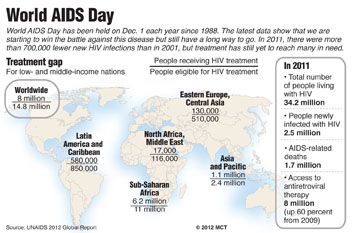On December 1, the world got together to spread word about AIDS, the disease that changed hundreds of millions of lives. World AIDS Day has been observed by all UN-member states since it was created in 1988 in Geneva, Switzerland by James W. Bunn and Thomas Netter; their goal was to control the amount of people who had AIDS by spreading awareness.
This World AIDS Day was commemorated by 193 countries around the world. In Manila, the capital city of the Philippines, an AIDS activist lit about 300 red candles in the shape of a ribbon. In Kuala Lumpur, Malaysia, Red Ribbon Youth Club organized all day events, like dance performances, a free hug campaign, flash mobs, and more to raise awareness and funds. Belarusian youths released red balloons in the shape of a ribbon in Smolevichi. Salvadorans participated in a march in San Salvador, El Salvador.
College students in the Indian city of Chandigarh wrote letters to India’s health ministry to cover people with HIV or AIDS, and nursing students held a candlelight vigil. Indonesian youths participated in the campaign Dance 4 Life to raise awareness in Jakarta. In Independence Square in Kiev, Ukraine, the Monument of Independence was lit red. Between columns in the north portico of the White House, where the International AIDS conference was held, a giant red ribbon was hung on World AIDS Day for the fifth consecutive year.
Twenty-four years after the first World AIDS Day, it is clear that the unwanted disease has outstayed its welcome. The organizers of the day commemorated worldwide. The Joint United Nationals Program on HIV/AIDS (UNAIDS) made this clear by choosing the theme Getting to Zero for World AIDS Day since 2011. Their goal is to make sure that there are no new HIV infections by 2015.
This year’s World AIDS Day report proved just that. The virus infected 700,000 fewer people in 2012 than in 2011. 72% of people who have AIDS live in Sub-Saharan Africa, with about 23 million people on the continent. Over the last ten years, the amount of new infections decreased by 25%. It decreased by 86% in Suriname, 73% in the Dominican Republic, and 50% in the Bahamas, Barbados, Belize and Haiti. Over the past decade, it reduced by 91% in Nepal, 8% in Cambodia, and 34% in Malaysia.
In 14 countries, AIDS related deaths decreased by 50% from 2005; half a million fewer people died globally. The main reason for this is the increase in funding for HIV and AIDS treatment in low and middle income countries, which increased by 54%. Many countries increased their domestic investment in AIDS by $4.7 billion from 2005 to 2011.
Infections in children decreased by 43% from 2003 to 2011. In low and middle income countries, the availability of anti-retroviral treatment to help prevent HIV transmission from mother to child has increased by 57%. Of the world’s pregnant women with HIV, 92% live in Sub-Saharan Africa and 59% were able to receive anti-retroviral therapy or prophylaxis during pregnancy, safely delivering in 2011. The risk of a mother under-treatment transmitting HIV to her infant has been reduced by 5%.
These numbers reflect the success of the campaign and UNAIDS is very proud of this. Getting to zero may be more achievable than people realize, but the truth of the matter is, every few steps taken forward are countered by steps taken backward. In many places around the world, the number of new infections has decreased rapidly, but there were still 25 million new HIV infections in 2011.
In the Middle East and North Africa, the number of new infections increased by 35% from 2001 to 2011, and continues to increase in Eastern Europe and Central Asia. North Africa is yet to see a reduction in HIV obtained by infants; More than 2,400 people get HIV each day in the world. The number of people who have access to HIV and AIDS treatment has increased, but there are still 46% of people with the virus that have no access to it, and it is possible that this number will grow. In underdeveloped counties, where HIV and AIDS are prominent it may be difficult to spend domestic funds on treatment, when they have other economic priorities.
UNAIDS definitely have a very optimistic goal: wanting to eliminate any new HIV infections by the year 2015. The amount of people who have been infected in recent years has improved, but it is unlikely that this goal will be reached. UNAIDS’ goal isn’t to literally get the number of new HIV infections down to zero, but to reduce it by 50%, which some might agree is much more realistic, yet still impressive. Getting awareness out to the ends of the earth will have an effect but the goal of seeing no new HIV infections may not be achieved in this lifetime.


